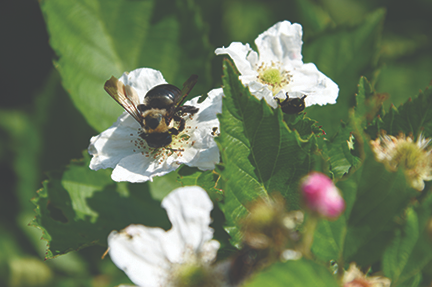Understanding the Pollinating Services of Native Bees
Above: Bumble bees buzz pollinate crops like tomatoes when they collect pollen, which they store in a ball on their hind legs.
It’s hard to deny the absolute benefits of the honey bee, but did you know that the European honey bee is not native to America? While acknowledging the benefits of the honey bee, I’d like to explore the benefits of native wild bees that you may not have been aware of.
Pollination is the primary task that bees and other organisms help us with. What is pollination? It is the successful transfer of viable pollen from the anther (male flower structure that produces pollen) to the stigma of the pistil (female part of the flower). Successful pollination is not only important, but it is essential to develop seed and fruit (the ripened ovary).
Bees and other pollinators are directly or indirectly responsible for one-third of Americans' food. Fruit, nut, and vegetable crops are especially dependent on bees and other pollinators. Other crops may be primarily wind-pollinated.
Entomologists from Purdue University and Ohio State University recently collaborated to author the Extension publication “Identifying Wild Bees as Pollinators of Indiana’s Specialty Crops.”
They said that there are over 400 species of native wild bees in Indiana. We tend to notice the big ones, like bumblebees. “Indiana’s wild bees provide free pollination services to a variety of specialty crops and can play an essential part in maintaining crop yields,” they wrote.
In general, bees live one of two ways: as a social bee in a collective hive, or solitarily. Hives have a single queen and each individual has a specific task. Solitary bees build their own nest, and while there may be aggregations of individual nests (neighbors if you will), solitary bees live on their own. Most native bees in Indiana are solitary bees.
Bumble bees are social bees, large-bodied and fuzzy with yellow or brown and black hair. Bumble bees pollinate blueberries, apples, watermelon, and other crops. “Bumble bees can buzz-pollinate, meaning they vibrate their abdomens when visiting some flowers (e.g., tomato), which often leads to more successful pollination,” they said.

Above photo: bumblebee on blackberry flower. Photo by Purdue University (publication POL-2).
Sweat bees are a diverse and abundant group of small solitary bees that commonly land on people’s arms for the salt in sweat. They come in many different colors, from black to metallic green or blue. They pollinate apples, blueberries, tomatoes, watermelon, and other crops.
Mining bees are small to medium-sized bees with vertical lines of pale hair between their eyes. They can be all dark or have light hair on their thorax, sometimes with white stripes on their abdomen. “Mining bees are some of the most abundant and diverse native bees in spring-flowering crops,” they said. “They are the most frequent wild bee visitors to apple flowers.” One species, the Carolina minor bee, almost exclusively visits blueberry flowers.
Cellophane bees are medium-sized bees, black or brown with white stripes on their abdomen and a heart-shaped head. They pollinate blueberries, apples, and other spring-blooming crops. “These bees get their name from the cellophane-like substance that they use to line their nests, which protects the eggs from winter damage,” they said.
Male long-horned bees have long antennae, while the females are large, hairy bees with yellow hair on their thorax and a black abdomen with hairy white stripes. The two-spotted longhorn bee, the most common in Indiana, is all black with two white spots on the back of its abdomen. They visit summer-flowering crops like watermelon. Also in this tribe are squash bees, which visit squash and other cucurbits.
Purdue entomologist Elizabeth Long recently wrote about mason bees. She said these solitary bees use hollow stems for their nesting sites, using mud to build a little wall to seal off each chamber or cell containing pollen, nectar, and an egg. “Mason bee adults only live for about 1 month (May-June) before their life span is complete, but that’s plenty of time for them to contribute to pollination and for you to enjoy hosting them!” she said.
The USDA Forest Service indicates that mason bees are also known as orchard bees, as they commonly pollinate fruit trees.
Michigan State University has an extension publication, “Building and Managing Bee Hotels for Wild Bees.” Although wild bees do not need human help, they accept hollow tubes provided by orchard growers and home gardeners for nesting. These multi-tube “hotels” are appropriate for mason bees and leafcutter bees, another native pollinator.
Find the above-referenced publication, “Identifying Wild Bees as Pollinators of Indiana’s Specialty Crops,” at https://extension.entm.purdue.edu/publications/POL-12/POL-12.html. Find Long’s original article at https://fff.hort.purdue.edu/article/mason-bees-for-fun-and-fruit-pollination-anyone/.
